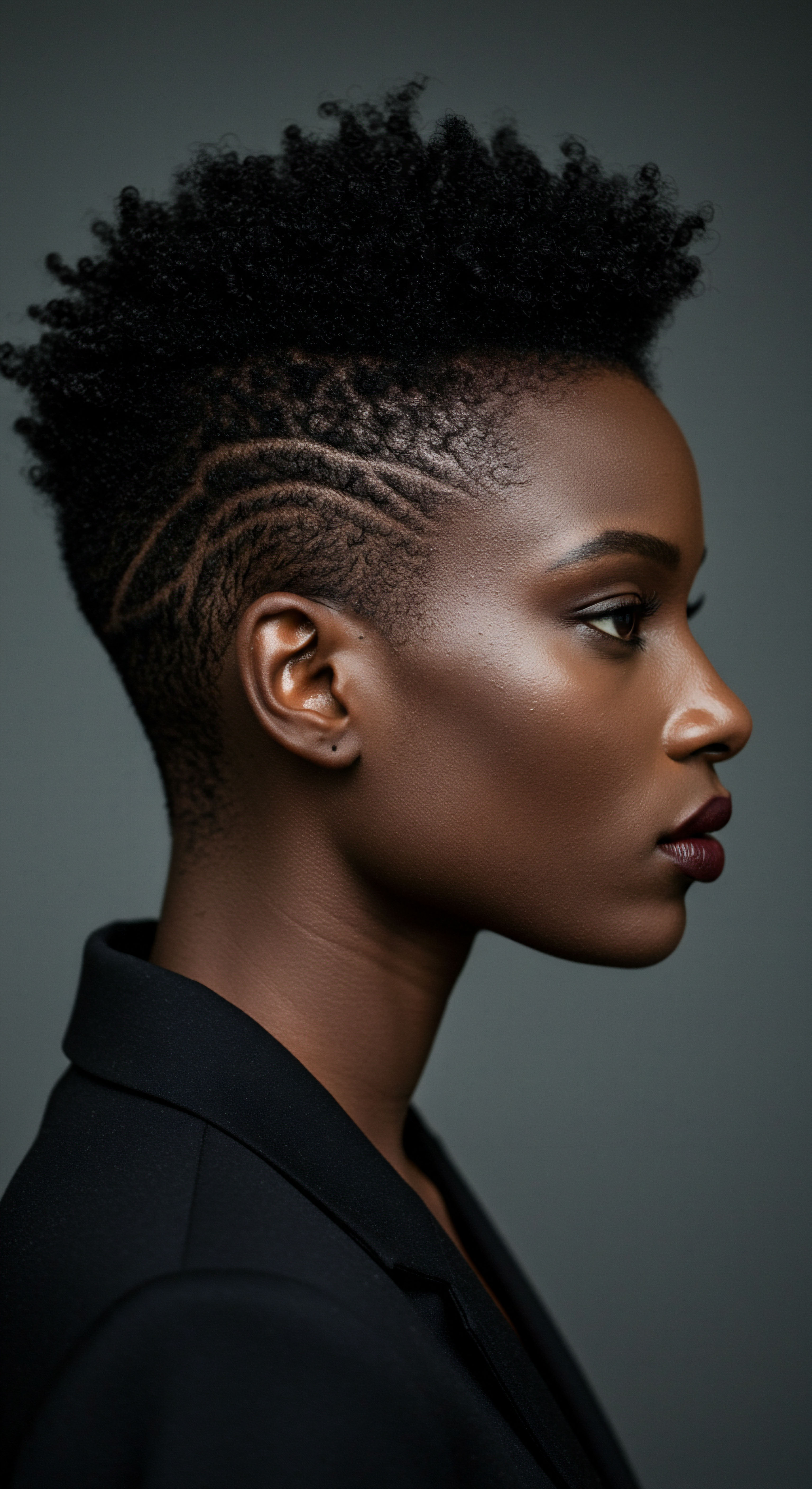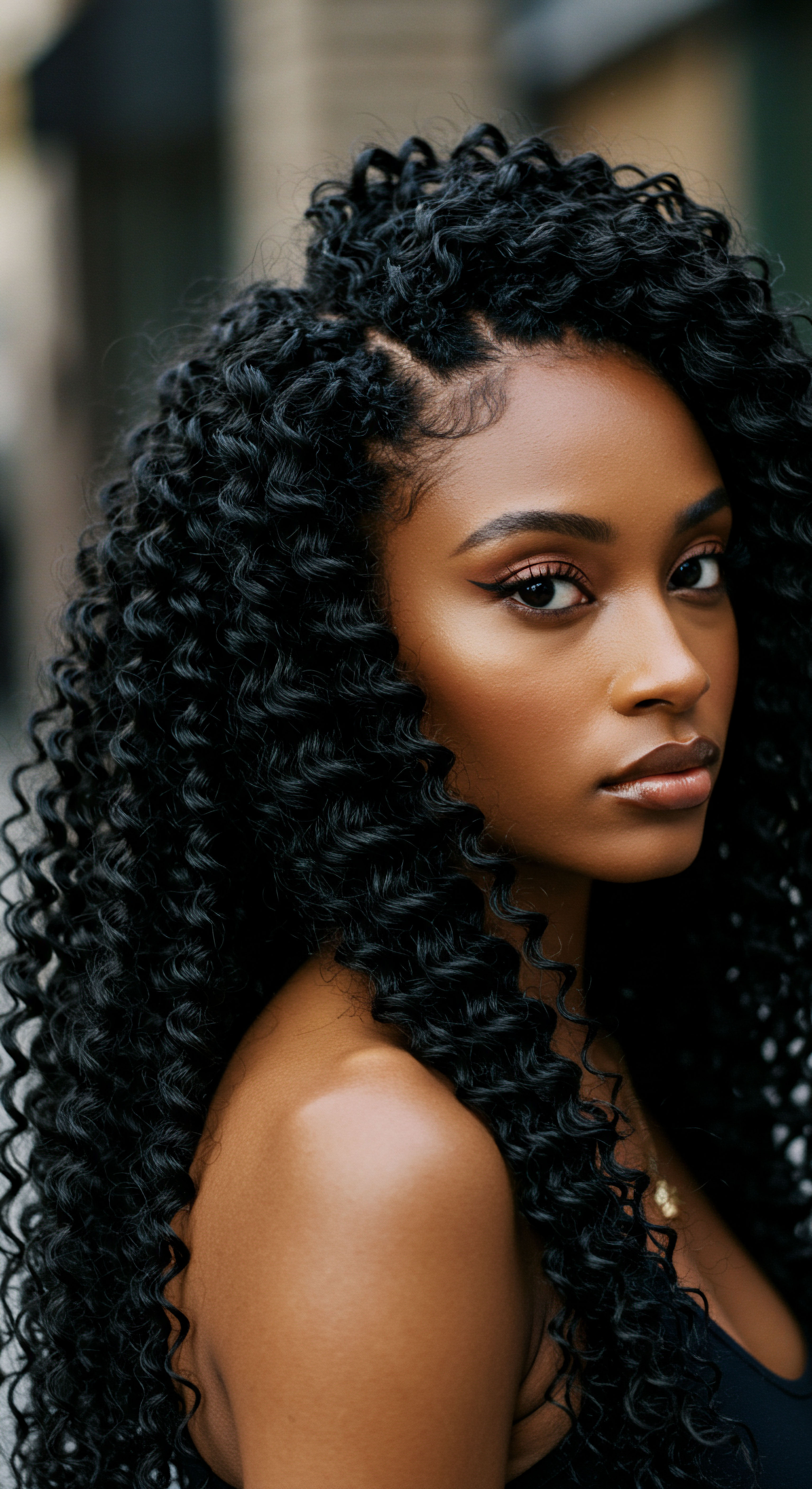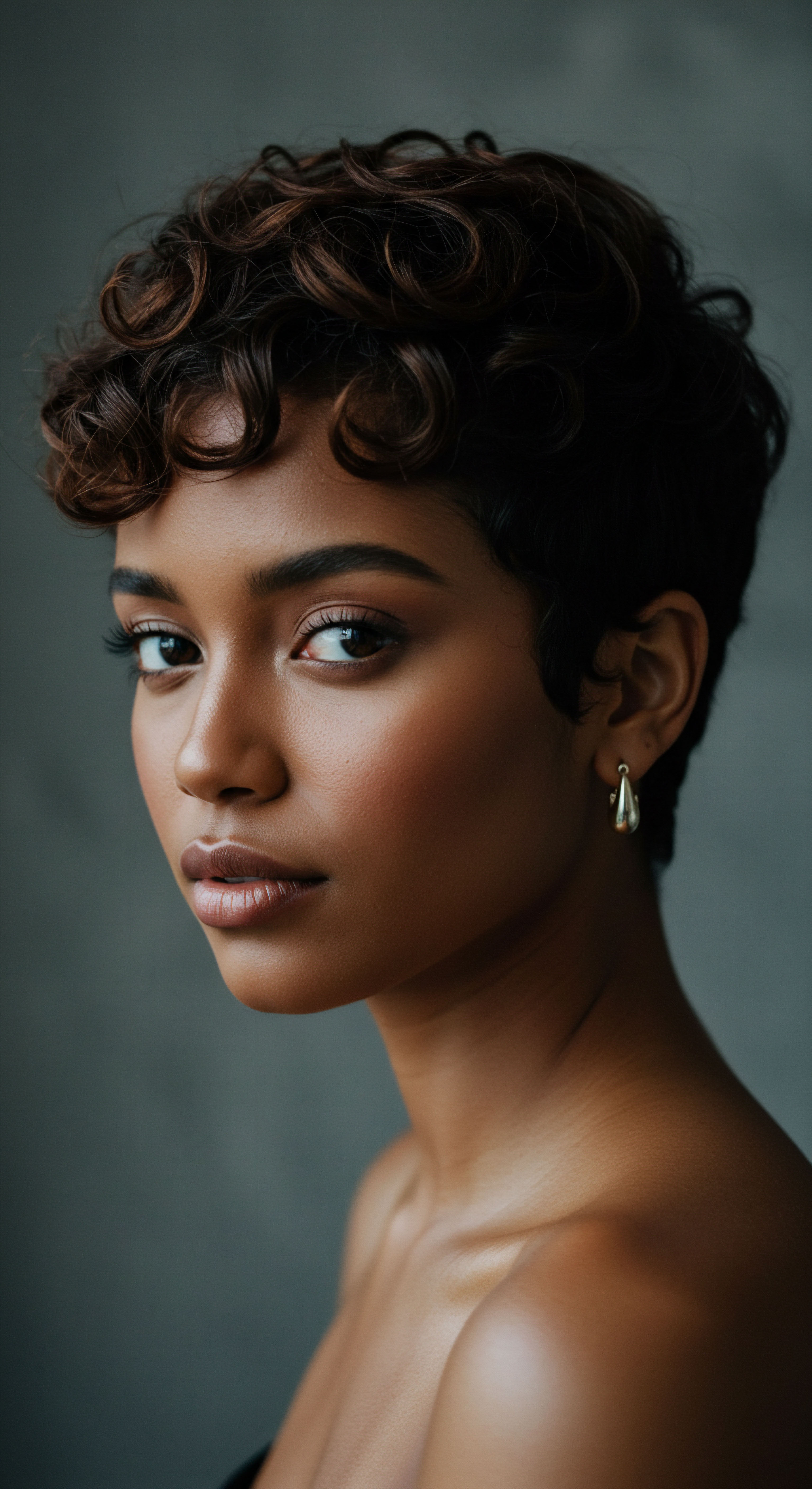
Roots
The quiet hours of night, when the world softens its hurried pace, hold a particular significance for our strands. While we seek repose, our hair, too, enters a period of vulnerability, encountering subtle forces that can shape its vitality over time. It is a time often overlooked in the broader conversation of hair wellness, yet the unseen interactions between our tresses and their resting environment quietly determine much of their long-term health and appearance. Understanding the foundational structure of our hair, particularly textured hair, provides the clearest window into why these nocturnal considerations are not merely a luxury, but a thoughtful practice for preserving its inherent beauty and resilience.
The unique architecture of textured hair, characterized by its distinctive coils, curls, and waves, presents both magnificent strength and a delicate susceptibility. Unlike straight hair, which possesses a more uniform, cylindrical shape, textured strands are elliptical, sometimes even flat, with varying points of curvature along their length. These natural bends and twists, while contributing to their breathtaking volume and spring, also mean that the cuticle, the outermost protective layer of the hair shaft, is not always uniformly smooth. At each curve, the cuticle scales may lift slightly, making these areas more prone to snagging, friction, and moisture loss.

Hair’s Delicate Outer Shield
The cuticle functions as the hair’s primary defense, a shimmering armor composed of overlapping, tile-like cells. When these cells lie flat and smooth, they reflect light beautifully, creating a healthy sheen, and more importantly, they seal in the hair’s precious internal moisture, the cortex. For textured hair, maintaining this smooth cuticle alignment is a constant gentle art. During sleep, as we shift and turn, our hair brushes against pillowcases and bedding.
This mechanical stress, seemingly benign, can cause those delicate cuticle scales to ruffle, lift, and eventually chip away. A compromised cuticle leaves the hair’s inner core exposed, leading to dehydration, brittleness, and eventually, breakage.
Consider the inherent thirst of textured hair. Its coiled structure makes it more challenging for natural oils produced by the scalp to travel down the entire length of the strand. This anatomical reality means textured hair often leans towards dryness, a condition exacerbated by environmental factors and daily manipulation. Nighttime care, therefore, becomes a crucial intervention, a quiet moment to counteract the day’s moisture depletion and fortify the hair against the subtle aggressions of friction.

How Does Hair Structure Influence Nighttime Care?
The varied shapes and patterns of textured hair necessitate tailored care. A Tightly Coiled Strand, for instance, may have more points of vulnerability due to its numerous bends, requiring extra diligence in protection. A looser curl, while still benefiting, might experience less direct friction damage compared to a tightly coiling counterpart. This understanding of hair’s individual physical characteristics guides the choice of nighttime protective styles.
Understanding the inherent structure of textured hair reveals its delicate susceptibility to friction and moisture loss during the night.
The scalp, too, plays a silent yet significant role in this nocturnal dialogue. A healthy scalp provides the foundation for healthy hair growth. During sleep, the scalp continues its cellular renewal processes. Protective styles that minimize tension on the scalp and allow for air circulation can support this natural regeneration, preventing irritation and ensuring the hair follicles remain undisturbed.
Furthermore, the natural shedding cycle of hair, though continuous, can be managed more effectively with mindful nighttime practices. Hair sheds approximately 50-100 strands daily as part of its natural growth cycle. When hair is left loose at night, these shed strands, along with those that break due to friction, can tangle with healthy strands, leading to larger knots and more significant hair loss during detangling sessions. A protective style collects these shed hairs, minimizing tangles and making morning detangling a gentler, less damaging process.
Ultimately, the foundational understanding of textured hair’s unique anatomy – its elliptical shape, the tendency of its cuticle scales to lift at curves, and its natural predisposition to dryness – provides the scientific underpinning for the importance of nighttime protective styles. These practices are not simply about convenience; they are about respecting the hair’s intrinsic design and providing it with the most conducive environment for sustained health and growth.

Ritual
Stepping into the realm of nighttime hair care is akin to entering a quiet sanctuary, where the hurried pace of the day gives way to mindful gestures of preservation. This is where practical wisdom meets daily habit, transforming the act of preparing for sleep into a meaningful ritual for our strands. It’s about recognizing that the journey to healthy hair extends beyond cleansing and conditioning; it includes the deliberate steps taken before rest, safeguarding the gains made and preparing for the new day. The choice of a protective style for the night is a thoughtful act, a quiet commitment to the longevity and vibrancy of our hair.

Selecting Your Nocturnal Shield
The landscape of protective styles for nighttime is diverse, each offering distinct benefits tailored to various hair lengths, textures, and personal preferences. The overarching aim remains consistent ❉ to minimize friction, reduce tangling, and preserve moisture.
- Pineapple ❉ This simple, yet remarkably effective style involves gathering all hair to the very top of the head, securing it loosely with a satin scrunchie. The resulting high bun or puff keeps the majority of the hair off the pillow, significantly reducing friction on the mid-lengths and ends. It is particularly well-suited for looser curls and waves.
- Braids ❉ Whether single braids, two large braids, or multiple smaller ones, braiding hair before sleep is a time-honored practice. Braids encapsulate the strands, preventing them from rubbing against each other or against bedding. This containment dramatically cuts down on tangles and breakage. Braids also help preserve moisture, as the hair’s surface area exposed to the air is reduced.
- Twists ❉ Similar to braids, twists (two-strand twists or flat twists) offer excellent protection. They are often preferred for their ability to stretch the hair gently, which can help maintain curl definition and reduce shrinkage for some textures. The act of twisting locks the hair in place, shielding it from external stressors.
- Buns ❉ A loose bun, positioned at the nape of the neck or on top of the head, provides a contained environment for the hair. It prevents widespread friction and helps maintain the shape of styled hair, such as a roller set or blow-out, by keeping it from flattening.
Beyond the style itself, the tools and accessories employed during this nightly ritual hold considerable sway. The material against which our hair rests is a silent determinant of its morning condition.
Nighttime protective styles act as a thoughtful shield, minimizing friction and tangling while preserving essential moisture.

The Essential Fabric of Protection
The choice of pillowcase or head covering can profoundly impact hair health. Cotton, a common bedding material, is known for its absorbency. While excellent for wicking away sweat, this property also means it draws moisture from the hair, leaving it drier and more susceptible to breakage. The coarse fibers of cotton also create friction, leading to frizz and mechanical damage to the cuticle.
Silk and satin, conversely, possess smooth surfaces that allow hair to glide effortlessly, drastically reducing friction. Their non-absorbent nature means they do not strip hair of its natural oils or applied products.
| Material Cotton |
| Surface Texture Rough, fibrous |
| Moisture Interaction Absorbs moisture from hair |
| Impact on Hair High friction, causes frizz, breakage, dryness |
| Material Satin |
| Surface Texture Smooth, slick |
| Moisture Interaction Non-absorbent |
| Impact on Hair Low friction, reduces frizz, preserves moisture |
| Material Silk |
| Surface Texture Very smooth, natural protein fibers |
| Moisture Interaction Non-absorbent |
| Impact on Hair Minimal friction, highly protective, gentle |
| Material Opting for satin or silk bedding significantly enhances nighttime hair protection. |
The wisdom of covering hair at night with a bonnet, scarf, or durag, particularly those made of satin or silk, extends across many cultures and generations. This practice offers an additional layer of defense, ensuring that hair remains contained and protected regardless of movement during sleep. It also helps to keep hair products sealed in, allowing them to work more effectively overnight.

Why Do Nighttime Rituals Feel So Right?
Beyond the tangible benefits of reduced breakage and preserved moisture, the consistent practice of nighttime hair care offers a sense of calm and control. It transforms a routine into a mindful ritual, a moment of gentle self-care at the close of each day. This dedicated time signals respect for one’s hair, acknowledging its needs and providing it with the attention it deserves.
The preparation involved in these rituals also sets the stage for easier mornings. Hair that has been protected overnight is less likely to be tangled, frizzy, or flattened, making styling quicker and less stressful. This translates to fewer minutes spent wrestling with unruly strands and more time enjoying the day. The gentle wisdom of these practices, passed down through generations, continues to serve as a cornerstone for maintaining healthy, vibrant textured hair.

Relay
The quiet act of preparing hair for sleep, often viewed as a simple routine, actually forms a sophisticated interplay of biological preservation, psychological comfort, and cultural continuity. This seemingly modest practice of protective styling at night extends far beyond mere aesthetic upkeep, touching upon the very resilience of the hair shaft and the broader human experience. To truly grasp its significance, we must consider the unseen forces at play and the subtle ways our hair responds to its nocturnal environment.

The Unseen Friction and Hair’s Response
At a microscopic level, the friction encountered by hair during sleep is a significant contributor to damage. As an individual shifts and turns, hair strands rub against the pillowcase, creating mechanical stress. This continuous abrasion, over hours, can lead to the lifting and eventual erosion of the hair’s outermost protective layer, the cuticle. Once compromised, the inner cortex, responsible for hair’s strength and elasticity, becomes exposed, making it susceptible to moisture loss and further structural degradation.
Research has quantified this impact. A study published in the Journal of the American Academy of Dermatology examined the mechanical properties of hair fibers under various conditions, including friction. While specific to friction, broader textile science research offers illuminating insights. For instance, studies on the coefficient of friction between hair fibers and different textile surfaces, such as those found in the Journal of Textile Institute, demonstrate that materials like cotton exhibit significantly higher friction coefficients compared to silk or satin.
This higher friction translates directly to increased mechanical wear on the hair cuticle. One notable finding from textile science research, while not directly on human hair in sleep, shows that materials with a higher coefficient of friction, like certain coarse cotton weaves, can cause up to 50% More Surface Abrasion on Delicate Fibers when subjected to repetitive movement compared to smoother counterparts like silk. This principle directly applies to hair, indicating that the cumulative effect of high-friction pillowcases over hours of sleep can lead to substantial cuticle damage and subsequent breakage for hair, particularly for textured strands which already possess naturally raised cuticle scales at their bends.
Nighttime protective styles reduce mechanical stress, preserving the hair’s delicate cuticle against the unseen abrasion of sleep.
The implications for textured hair are particularly pronounced. The natural curves and bends in coiled and curly strands mean that the cuticle scales are already more prone to lifting at these points. When subjected to high friction from a cotton pillowcase, these vulnerable areas experience accelerated damage, leading to frizz, dullness, and breakage. Protective styles, by containing the hair and minimizing its direct contact with abrasive surfaces, act as a vital buffer against this nightly assault.

Moisture Preservation and Hydro-Fatigue
Beyond mechanical stress, nighttime also presents a challenge to hair’s moisture balance. Hair, especially textured hair, thrives on moisture. When hair is left exposed, it can lose water to the surrounding air, particularly in dry environments or through absorption by moisture-wicking fabrics like cotton. This constant fluctuation in moisture content, known as hydro-fatigue, weakens the hair shaft over time.
Protective styles, especially when combined with a satin or silk covering, create a micro-environment around the hair that helps to trap and preserve moisture. This allows the hair to remain hydrated throughout the night, reducing the cycle of swelling and contracting that contributes to hydro-fatigue. The gentle compression and containment offered by styles like braids or twists also help to keep applied leave-in conditioners and oils sealed onto the hair, maximizing their restorative effects.

The Interplay of Science and Cultural Practice
The wisdom of nighttime hair protection is not a modern invention; it echoes through centuries of cultural practices across diverse communities. Head coverings for sleep have been a part of many hair care traditions, particularly within Black and Indigenous cultures, long before scientific studies quantified their benefits. These practices, often passed down through generations, speak to an intuitive understanding of hair’s vulnerability and the need for its safeguarding.
For example, the widespread use of headwraps and bonnets in African diasporic communities for nighttime protection is a powerful testament to this inherited knowledge. This practice transcends mere utility; it connects individuals to a lineage of care, resilience, and beauty. The cultural continuity of these practices underscores their profound efficacy and their role in maintaining hair health within specific hair types that are historically susceptible to damage without proper care.
Moreover, the psychological benefits of these rituals are significant. The act of caring for one’s hair before sleep can be a meditative, grounding experience. It provides a sense of agency and self-connection, fostering a positive relationship with one’s hair.
This psychological comfort, while less tangible than reduced breakage, contributes to overall well-being and a more holistic approach to hair care. The ritualistic nature of preparing hair for sleep can reduce anxiety about morning styling, promoting a more restful night.
In essence, nighttime protective styles are a convergence of scientific understanding and cultural wisdom. They offer a tangible solution to the mechanical and environmental stressors hair faces during sleep, while also providing a deep connection to heritage and a moment of personal care. This multifaceted approach is what makes them an indispensable part of comprehensive hair wellness.

Reflection
As the quiet settles each evening, the decision to shelter our hair in a protective style is more than a simple step in a beauty routine; it is a profound acknowledgment of its inherent needs and a gentle investment in its enduring health. It is a dialogue between the day’s exertions and the restorative promise of night, where conscious care transforms vulnerability into strength. This practice, grounded in both the intimate knowledge of our hair’s structure and the collective wisdom of generations, offers a pathway to not only preserve but truly celebrate the vitality of our strands, ensuring they awaken as beautifully as they deserve.

References
- K. J. White and A. L. Cook, “The Frictional Properties of Human Hair Fibers and Textile Surfaces,” Journal of the Textile Institute, vol. 101, no. 1, pp. 69-76, 2010.
- Robbins, C. R. Chemical and Physical Behavior of Human Hair. Springer, 2012.
- Bhushan, B. Introduction to Tribology. John Wiley & Sons, 2002.
- Franbourg, A. Hallegot, P. Baltenneck, F. Freyssinet, J. M. & Bouillon, C. “The Human Hair Follicle ❉ A Unique Miniorgan for the Study of Hair Biology.” Experimental Dermatology, vol. 12, no. 5, pp. 531-540, 2003.
- Gavazzoni Dias, M. F. R. “Hair Cosmetics ❉ An Overview.” International Journal of Trichology, vol. 7, no. 1, pp. 2-15, 2015.
- Dawber, R. P. R. Diseases of the Hair and Scalp. Blackwell Science, 1997.
- Draelos, Z. D. Cosmetic Dermatology ❉ Products and Procedures. Wiley-Blackwell, 2010.
- Swift, J. A. “The mechanical properties of hair.” International Journal of Cosmetic Science, vol. 18, no. 5, pp. 225-236, 1996.